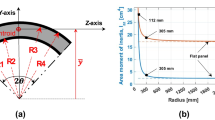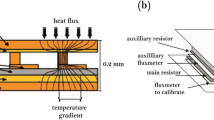Abstract
This study presents a design method for predicting the static strength of a Circular Hollow Section (CHS) tubular K-joint at elevated temperature. The presented method is obtained based on a parametric study by the authors (He et al., 2015a). In determining the static strength of a tubular K-joint at elevated temperature, a deforming rate criterion is proposed, and it is proved to be much safer and more reasonable for design purposes rather than the conventional definition on that static strength by using 3% of chord ovalisation for the K-joint at ambient temperature. In the presented design method, a strength reduction factor k is proposed, and the static strength of a CHS K-joint at elevated temperature can be obtained simply by multiplying the static strength at ambient temperature with k. The strength reduction factor k is a product of two factors, a revised reduction factor of elastic modulus (λ) and a revised chord stress ratio (k n′, θ ). From the finite element results of overall 57 K-joint models, the accuracy of the presented design method is assessed to be reliable and accurate.
Similar content being viewed by others
References
American Welding Society (AWS) (2000). Structural welding codesteel, AWS D1.1.
Chen, C., Shao, Y. B., and Yang, J. (2013). “Experimental and numerical study on fire resistance of circular tubular T-joints.” Journal of Constructional Steel Research, Vol. 85, No. 6, pp. 24–39, DOI: 10.1016/j.jcsr.2013.02.013.
Eurocode 3 (EC3) (2005). Design of steel structures-Part 1-2: General rules-Structural fire design, European Committee for Standardization, EN1993-1-2, CEN. Brussels, Belgium.
Feng, R. and Young, B. (2012). “Design of cold-formed stainless steel tubular joints at elevated temperatures.” Engineering Structures, Vol. 35, No. 2, pp. 188–202, DOI: 10.1016/j.engstruct.2011.10.029.
Gao, F., Guan, X. Q., Zhu, H. P., and Xia, Y. (2015). “Hysteretic behaviour of tubular T-joints reinforced with doubler plates after fire exposure.” Thin-Walled Structures, Vol. 92, No. 7, pp. 10–20, DOI: 10.1016/j.tws.2015.02.010.
Gao, F., Zhu, H. P., and Liu, X. N. (2013). “Failure behaviour of axially tubular Y-joints under fire.” Advances in Structural Engineering, Vol. 16, No. 9, pp. 1523–1534, DOI: 10.1260/1369-4332.16.9.1523.
He, S. B., Shao, Y. B., and Zhang, H. Y. (2015b). “Evaluation on fire resistance of tubular K-joints based on temperature method.” Journal of Constructional Steel Research, Vol. 115, No. 12, pp. 398–406, DOI: 10.1016/j.jcsr.2015.08.034.
He, S. B., Shao, Y. B., Zhang, H. Y., and Wang, Q. L. (2015a). “Parametric study on performance of circular tubular K-joints at elevated temperature.” Fire Safety Journal, Vol. 71, No. 1, pp. 174–186, DOI: 10.1016/j.firesaf.2014.11.001.
He, S. B., Shao, Y. B., Zhang, H. Y., Yang, D. P., and Long, F. L. (2013). “Experimental study on Circular Hollow Section (CHS) tubular Kjoints at elevated temperature.” Engineering Failure Analysis, Vol. 34, No. 12, pp. 204–216, DOI: 10.1016/j.engfailanal.2013.07.035.
Jin, M., Zhao, J. C., Chang, J., and Zhang, D. X. (2012). “Experimental and parametric study on the post-fire behavior of tubular T-joint.” Journal of Constructional Steel Research, Vol. 70, No. 3, pp. 93–100, DOI: 10.1016/j.jcsr.2011.07.018.
Jin, M., Zhao, J. C., Liu, M. L., and Chang, J. (2011). “Parametric analysis of mechanical behavior of steel planar tubular truss under fire.” Journal of Constructional Steel Research, Vol. 67, No. 1, pp. 75–83, DOI: 10.1016/j.jcsr.2010.07.012.
Liu, M. L., Zhao, J. C., and Jin, M. (2010). “An experimental study of the mechanical behavior of steel planar trusses in a fire.” Journal of Constructional Steel Research, Vo. 66, No. 4, pp. 504–511, DOI: 10.1016/j.jcsr.2009.11.005.
Lu, L. H., de Winkel, G. D., Yu, Y., and Wardenier, J. (1994). “Deformation limit for the ultimate strength of hollow section joints.” Proceedings of the Sixth International Symposium on Tubular Structures, Australia, pp. 341-347.
Nguyen, M. P., Fung, T. C., and Tan, K. H. (2010). “An experimental study of structural behaviours of CHS T-joints subjected to brace axial compression in fire condition.” Tubular Structures XIII, Hong Kong, pp. 725–732.
Nguyen, M. P., Tan, K. H., and Fung, T. C. (2010). “Numerical models and parametric study on ultimate strength of CHS T-joints subjected to brace axial compression under fire condition.” Tubular Structures XIII, Hong Kong, pp. 733–740.
Ozyurt, E., Wang, Y. C., and Tan, K. H. (2014). “Elevated temperature resistance of welded tubular joints under axial load in the brace member.” Engineering Structures, Vol. 59, No. 2, pp. 574–586, DOI: 10.1016/j.engstruct.2013.11.014.
Tan, K. H., Fung, T. C., and Nguyen, M. P. (2013). “Structural behavior of CHS T-joint subjected to brace axial compression in fire condition.” Journal of Structural Engineering, ASCE, Vol. 139, No. 1, pp. 73–84, DOI: 10.1061/(ASCE)ST.1943-541X.0000604.
Xu, J. X., Zhao, J. C., Song, Z. S., and Liu, M. L. (2012). “Prediction of ultimate bearing capacity of tubular T-joint under fire.” Safety Science, Vol. 50, No. 7, pp. 1495–1501, DOI: 10.1016/j.ssci.2012.02.004.
Yu, W. J., Zhao, J. C., Luo, H. X., Shi, J. Y., and Zhang, D. X. (2011). “Experimental study on mechanical behavior of an impacted steel tubular T-joint in fire.” Journal of Constructional Steel Research, Vol. 67, No. 9, pp. 1376–1385, DOI: 10.1016/j.jcsr.2011.03.001.
Zhao, X. L., Herion, S., Packer, J. A., Puthli, R., Sedlacek, G., Wardenier, J., Weynand, K., van Wingerde, A., and Yeomans, N. (2000). Design guide for circular and rectangular hollow section joints under fatigue loading, CIDECT Publication No.8, TUV-Verlag, Germany.
Author information
Authors and Affiliations
Corresponding author
Rights and permissions
About this article
Cite this article
Shao, Y., He, S. & Yang, D. Prediction on static strength for CHS tubular K-joints at elevated temperature. KSCE J Civ Eng 21, 900–911 (2017). https://doi.org/10.1007/s12205-016-0805-x
Received:
Revised:
Accepted:
Published:
Issue Date:
DOI: https://doi.org/10.1007/s12205-016-0805-x




